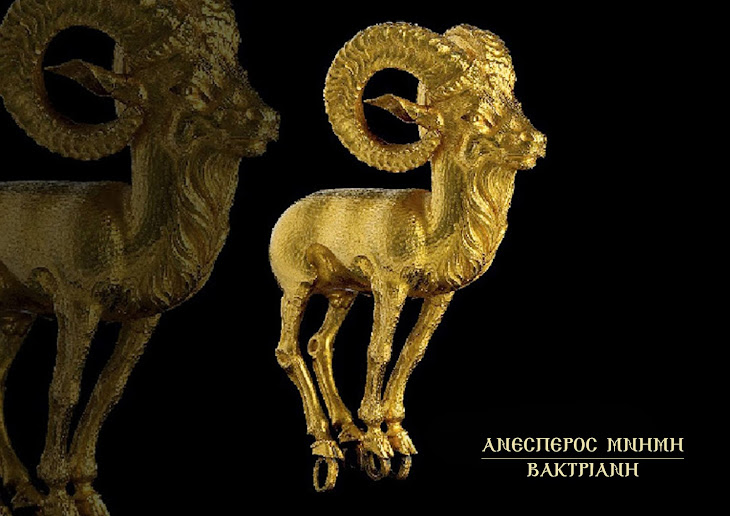The
unveiling of a 4,000-year-old civilization calls into question conventional
ideas about ancient culture, trade, and religion.
Viktor
Sarianidi, barefoot at dawn, surveys the treeless landscape from a battered
lawn chair in the Kara-Kum desert of Turkmenistan. "The mornings here are
beautiful," he says, gesturing regally with his cane, his white hair wild
from sleep. "No wife, no children, just the silence, God, and the
ruins."
Viktor
Sarianidi spends nearly half of every year digging in Turkmenistan's Kara-Kum
desert.
Courtesy of
Kenneth Garrett
Where
others see only sand and scrub, Sarianidi has turned up the remnants of a wealthy
town protected by high walls and battlements. This barren place, a site called
Gonur, was once the heart of a vast archipelago of settlements that stretched
across 1,000 square miles of Central Asian plains. Although unknown to most
Western scholars, this ancient civilization dates back 4,000 years—to the time
when the first great societies along the Nile, Tigris-Euphrates, Indus, and
Yellow rivers were flourishing.
Thousands
of people lived in towns like Gonur with carefully designed streets, drains,
temples, and homes. To water their orchards and fields, they dug lengthy canals
to channel glacier-fed rivers that were impervious to drought. They traded with
distant cities for ivory, gold, and silver, creating what may have been the
first commercial link between the East and the West. They buried their dead in
elaborate graves filled with fine jewelry, wheeled carts, and animal
sacrifices. Then, within a few centuries, they vanished.
News of
this lost civilization began leaking out in the 1970s, when archaeologists came
to dig in the southern reaches of the Soviet Union and in Afghanistan. Their
findings, which were published only in obscure Russian-language journals,
described a culture with the tongue-twisting name Bactria-Margiana
Archaeological Complex. Bactria is the old Greek name for northern Afghanistan
and the northeast corner of Iran, while Margiana is further north, in what is
today Turkmenistan and Uzbekistan. Through the region runs the Amu Dar'ya
River, which was known in Greek history as the Oxus River. Western scholars
subsequently used that landmark to dub the newly found culture the Oxus
civilization.
The initial
trickle of information dried up in 1979 when the revolution in Iran and war in
Afghanistan locked away the southern half of the Oxus. Later, with the 1990
fall of the Soviet Union, many Russian archaeologists withdrew from Central
Asia. Undeterred, Sarianidi and a handful of other archaeologists soldiered on,
unearthing additional elaborate structures and artifacts. Because of what they
have found, scholars can no longer regard ancient Central Asia as a wasteland
notable primarily as the origin of nomads like Genghis Khan. In Sarianidi's
view, this harsh land of desert, marsh, and steppe may instead have served as a
center in a broad, early trading network, the hub of a wheel connecting goods,
ideas, and technologies among the earliest of urban peoples.
Courtesy of
Kenneth Garrett
Harvard
University archaeologist Carl Lamberg-Karlovsky believes the excavation at
Gonur is "a major event of the late 20th century," adding that
Sarianidi deserves credit for discovering the lost Oxus culture and for his
"30 consecutive years of indefatigable excavations." To some other
researchers, however, Sarianidi seems more desert eccentric than dispassionate
scholar. For starters, his techniques strike many colleagues as brutish and
old-fashioned. These days Western archaeologists typically unearth sites with
dental instruments and mesh screens, meticulously sifting soil for traces of
pollen, seeds, and ceramics. Sarianidi uses bulldozers to expose old
foundations, largely ignores botanical finds, and publishes few details on
layers, ceramics, and other mainstays of modern archaeology.
His
abrasive personality hasn't helped his cause, either. "Everyone opposes me
because I alone have found these artifacts," he thunders during a midday
break. "No one believed anyone lived here until I came!" He bangs the
table with his cane for emphasis.
Sarianidi
is accustomed to the role of outsider. As a Greek growing up in Tashkent,
Uzbekistan, under Stalinist rule, he was denied training in law and turned to
history instead. Ultimately, it proved too full of groupthink for his taste, so
he opted for archaeology. "It was more free because it was more ancient,"
he says. During the 1950s he drifted, spending seasons between digs unemployed.
He refused to join the Communist Party, despite the ways it might have helped
his career. Eventually, in 1959, his skill and tenacity earned him a coveted
position at the Institute of Archaeology in Moscow, but it was years before he
was allowed to direct a dig.
The ancient
Oxus culture may have arisen at sites like Anau, a settlement at the base of
the Kopet-Dag mountains, which dates back to 6500 B.C. Later settlements like
Gonur, roughly 4,000 years old, may have been founded by people from the
Kopet-Dag cultures.
An apparent
royal burial site at Gonur contains luxury goods, a cart with bronze-sheathed
wheels, and the remains of a camel.
An American
team works at Anau, in the foothills of the Kopet-Dag mountains.







Δεν υπάρχουν σχόλια:
Δημοσίευση σχολίου